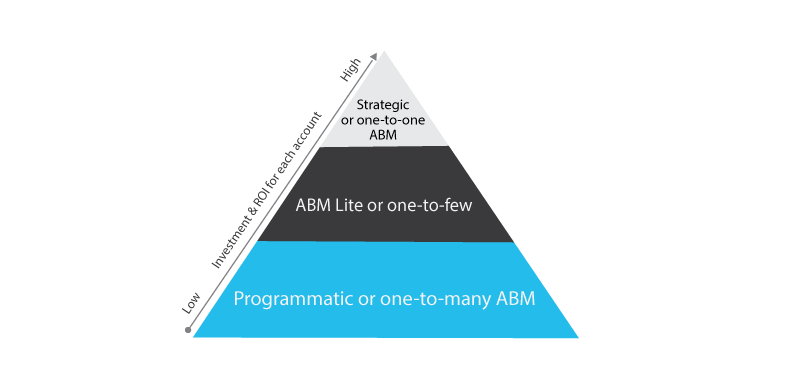In today’s competitive B2B market, generating leads and converting them into potential consumers is a challenge for marketers. Marketers can find new ways to reach their potential customers through account-based marketing strategy. ABM offers a strategic solution by allowing businesses to build strong, personalized relationships with high-value accounts. ABM prioritizes targeted outreach and content tailored to specific needs, fostering trust and understanding, ultimately leading to successful partnerships.
This strategic approach is focused on utilizing marketing tactics for B2B demand generation, establishing individualized connections with high-value target customers. ABM is focused on tailoring the purchasing experience of your potential consumers to improve their satisfaction, cultivate stronger relationships, and promote corporate growth. This is a clear and complete guide to account-based marketing that explores the importance of ABM, its key components, and emerging trends shaping the future of B2B marketing.
“As marketers say, how can we make this content available for the accounts that our sales teams want to close? That’s account-based marketing” – Sangram Vajre
What is Account-Based Marketing?
Account-based marketing is an emerging marketing approach that is focused on the identification and approaching of the best-fit lead consumers and applying all your marketing efforts and tactics to convert those prospects into loyal customers. In the B2B arena, it’s an essential marketing approach to utilize your all resources energy, time, and tactics to grab the attention of your ideal consumers. Account-based marketing strategy is considered by B2B business organizations, which tend to generate revenue by identifying and driving best-fit leads or prospects.

Understanding Account-Based Marketing Strategy
Importance of ABM
The ABM approach, particularly in the realm of tech marketing, is considered more effective for revenue growth as it bypasses the traditional lead-based funnel and focuses on high-priority accounts. First of all, ABM enables customized marketing, meeting the growing need for customer interactions that are catered through personalized messages for individual accounts. B2B marketers can enhance customer experiences from the point of initial interactions through ABM, which encourages the sales and marketing team to work together throughout the buyer experience. Through the utilization of intent marketing, marketers can identify the activities, behaviors, and patterns that mirror the interests of targeted consumers or accounts. Tracking the impact of marketing on high-valued accounts is made easier and resource allocation is streamlined when team members work together to identify target accounts and create customized programs.
Furthermore, ABM tends to shorten the sales cycle by including numerous stakeholders early on and nurturing all prospects concurrently. Moreover, ABM-focused targeting makes more accurate ROI evolution possible; indicators like revenue growth, transaction size, and client retention show success, and it can significantly enhance its effectiveness when integrated into a well-defined go-to-market strategy. ABM reduces resource waste by concentrating efforts on customers with the highest conversation rates.
Types of Account-Based Marketing
It is becoming more typical to see B2B companies using various forms of ABM into their marketing programs to accomplish their goals, as the ABM discipline continues to influence marketing efforts.
These are the three types of ABM:
1: Strategic or one-to-one ABM: The first method of account-based marketing campaign is one-to-one, or strategic ABM, which targets an organization’s most ideal customer profile. It is often led by one or two key members of the marketing team. The one-to-one approach with hyper-personalized ads is crucial for high-value clients. These clients present the greatest opportunity for upselling but also hold the highest risk of churn if they feel neglected by the competition.
2: ABM Lite or one-to-few: ABM Lite focuses on account-based marketing frameworks that are either second-tier accounts that are still important or accounts that are still strategic but cannot be handled with full ABM owing to resource limitations. It involves focusing on a group of important accounts with comparable demands and traits. In comparison to pursuing a one-on-one approach, this strategy focuses on the critical accounts that have smaller revenue or upsell potential.
3: Programmatic or one-to-many ABM: The third level of account-based marketing framework ABM includes programmatic or one-to-many marketing, which instead of focusing on five to ten accounts tends to divide accounts based on similar criteria. Based on customer characteristics, programmatic ABM clusters thousands or even hundreds of accounts. To plan and distribute customized communications, teams usually utilize marketing automation platforms or CRM software. Smaller companies may use the programmatic ABM, to effectively target clients with their fewer resources, which prioritizes customer-centric initiatives while maximizing efficiency.

Key Components of ABM
Identifying target accounts: Choose which accounts or segments to focus on for your ABM campaign. Ideal accounts can be identified through a mix of characteristics such as technographics, firmographics, fit, intent, and behavioral signals. They can then be ranked and scored based on revenue potential, strategic importance, and likelihood to purchase using predictive analytics or AI-driven tools. The scope and nature of selected accounts will depend on the organization’s goals, available resources, and budget.
Creating personalized content: Once you obtain the accounts, you must produce and distribute reliable, personalized, and appealing content that resonates with the needs of your ideal customer profile. It is necessary to comprehend your goals, preferences, and pain points as well as those of decision-makers. Map your content to the channels that your accounts utilize and the buyer journey as well. Each customer has unique possibilities and difficulties, and your massaging and content should highlight these pain points to show how your solutions may assist in achieving their goals.
Building the ABM team:

Fostering alignment and collaboration between your sales and marketing teams is one of the prime advantages of ABM. Your team’s roles and responsibilities must be in agreement with your objectives, analytics, accounts, content, and message. For your ABM initiatives to be planned, carried out, and optimized as well as to provide your accounts with a consistent and smooth experience your sales and marketing teams should collaborate. Even 82% of B2B marketers say ABM greatly improves sales and marketing team alignment.
Execution and optimization: The ultimate phase involves launching and overseeing your ABM initiatives, adapting them as necessary according to performance and input. Employ suitable tools and platforms to execute campaigns across various channels and touchpoints. Monitor and evaluate metrics and KPIs to gauge impact and ROI. Experiment with different elements like content, messaging, and timing to optimize results for each account and segment. Utilize feedback from accounts, sales, and marketing to enhance campaigns and relationships.
Benefits of Account-Based Marketing (ABM) Strategy
The use of account-based marketing campaigns has increased in recent years as businesses have recognized its potential to improve their marketing efforts and build lasting relationships with their target audience. With ABM, sales and marketing teams can align their efforts and work together to achieve goals, including nurturing highly valued accounts. This cooperative approach improves communication, increases operational efficiency, and leads to better business results. Unlike broader marketing initiatives that spread resources thin, ABM concentrates resources on a select group of high-potential accounts, driving focused B2B demand generation. This personalized approach ensures that messages resonate deeply with target businesses, avoiding the one-size-fits-all approach used in conventional methods.
One of the key advantages of ABM is its collaborative nature, which simplifies the nurturing process and enables targeted messaging tailored to the unique needs of each account. Additionally, collaborating with sales and customer success teams allows B2B marketers to refine ideal customer profiles, using insights from existing customers and market research to enhance campaign effectiveness. Furthermore, data obtained from ongoing ABM campaigns helps optimize future strategies, resulting in higher engagement rates and more impactful outcomes. By targeting decision-makers and influencers across the buying spectrum, ABM ensures comprehensive coverage, influencing key stakeholders at crucial touchpoints.
Implementing Account-Based Marketing (ABM) Strategy
For adopting an ABM approach for targeted marketing initiatives, marketers must understand the dynamics of the B2B buying committees, ensuring tailored strategies resonate effectively within each account’s decision-making framework.
Step 1: Identification of high-value accounts
In the initial stage, it is necessary to identify highly valued accounts based on the goals and objectives of your business. The identification of highly valued accounts should be based on their potential to generate revenue for your firm, as well as on the prospects of your ideal accounts who are likely to resonate with your products and services.
Step 2: Research and optimization
Following the identification of highly valued accounts, the next step in the ABM strategy is to understand the key considerations, needs, and pain points of the targeted accounts. In this process, you need to explore the current solutions they have and why the problem still exists, including where your target audience is in the customer journey framework. These inputs will help you craft customized content and messages that resonate with their challenges.
Step 3: Segmentation and prioritizing
Segmenting highly valued and targeted accounts is the next step in ABM’s strategic implementation, where you need to filter consumer profiles based on region, industry, company size, or other factors. Segmenting customer profiles helps customize your campaigns and enhance your reach accordingly. Focusing on accounts that can convey likelihood can enhance the effectiveness of your ABM strategy.
Step 4: Develop a customized marketing strategy
Create tailored content for every targeted account using information from your research process. This curated content should focus on the specific pain points and requirements of your targeted accounts, rather than taking a one-on-one approach individually. Get engaged with your sales and marketing team to ensure your proposed campaigns are appealing and reliable to connect with your audience.
Best Practices for Successful ABM

The key to utilizing B2B account-based marketing tactics ABM successfully is to leverage its advantages in identifying high-value customers, developing customized marketing tactics, and nurturing and growing existing client relationships. ABM offers a potentially superior return on investment (ROI) compared to other marketing tactics, with 97% of marketers reporting this benefit. By implementing ABM strategies, you can redefine your marketing efforts, enabling your sales and marketing team to attract and retain high-value clients.
Tailored value positioning: ABM necessitates creating customized messaging and content initiatives that tackle the specific challenges of your ideal customers. Crafting value propositions through ABM can address the specific challenges and pain points of targeted accounts, highlighting the value of your products and services and enhancing B2B brand awareness. In addition, ABM can be enhanced by integrating performance marketing tactics to optimize campaign delivery and maximize ROI for targeted high-value accounts. It can be enhanced by integrating performance marketing tactics to optimize campaign delivery and maximize ROI for targeted high-value accounts.
Stakeholder mapping and website customization: Mapping the stakeholders of your targeted accounts helps you understand their key roles and responsibilities. Develop communication strategies to engage these decision-makers and build long-term relationships through personalized interactions. Additionally, creating customized landing pages featuring relevant case studies can connect with your target accounts and increase engagement with key decision-makers.
Social selling and event experiences: Social media platforms like Facebook, LinkedIn, Twitter, or TikTok offer various content options to increase interactions and build relationships with your targeted accounts. Personalized content sharing, networking with important stakeholders, and participation in pertinent conversations all contribute to the development of long-lasting connections and authenticity. Building relationships with your target audience may be facilitated by holding live events, webinars, open forums, and roundtable conversations on subjects related to your target accounts. These events can present customized content focused on the challenges and pain points of your accounts, providing a unique experience.
Targeted content: Content strategy has always been a key aspect of grabbing the attention of your target audience. Utilizing high-quality content can speak directly to your target accounts about their needs, requirements, pain points, and desired outcomes. Developing an ABM strategy for success involves maintaining consistency in presentation and thriving on crafting a targeted strategy that fosters personalized relationships with high-value accounts, ultimately driving long-term revenue growth.
The ABM Advantage: Success Stories in Action
Personalization is a crucial component of B2B marketing, making these techniques essential components of your overall tech marketing strategy. Here are some account-based marketing examples to learn the best-fit ABM for your products and services:
Salesforce: Salesforce introduced a different CRM experience, “Connecting Tower,” which takes the user into the virtual world of smart buildings and showcases how their software increases the seamless experience of customer interactions. It’s a journey that explains Salesforce’s values and it was successful, they closed a large contract as a result.
Intridea: Intridea, a renowned website and mobile application designing company has introduced a billboard that grabbed the attention of the eyes, displaying the renowned ad agency “Ogilvy and Mather”. The billboard directly challenged Ogilvy to hire Intridea to level up their game. The ad also included a personalized URL with hilarious GIFs guaranteed to make a quick and memorable impact.
LiveRamp: A renowned organization known for identification resolution, assists firms in integrating offline client data with internet marketing tools. This provides advertisers with complete insights into analytics, targeting, and tailored content. They secured Fortune 500 organizations using hyper-targeted ABM, resulting in an impressive conversion rate in four weeks. What’s the lesson? Focus on high-value accounts and develop methods to personalize ABX, account-based experiences for long-term success.
ABM Challenges and Solutions
B2B account-based marketing best practices is considered a strategic option that can deliver a higher rate of return for the B2B markets. However, a few obstacles are faced by marketers while implementing the strategy:
- Budget and resources: Securing the optimal budget and resources can be challenging. Many ABM tactics require a significant investment, making it difficult for marketers with limited resources. In such cases, smaller investments in targeted content and leveraging customer testimonials can be effective alternatives.
- Engaging key accounts: Connecting with key decision-makers within target accounts is another hurdle. While implementing communication through multiple channels is important, smaller, targeted campaigns can be more efficient. These campaigns can help you observe user behavior and engagement patterns, allowing you to refine your strategies and develop strong interactions, ultimately leading to successful ABM implementation.
- Sales and marketing alignment: Aligning sales and marketing teams can be difficult due to their differing goals and priorities. These teams often have different sets of measurement metrics and indicators (KPIs). Collaborative discussions, shared goals, and the use of common measurement tools are key to creating strong alignment and ensuring successful ABM campaign implementation.
- Scalability: The high level of personalization and customization required in ABM can hinder scalability, especially for companies with a large number of target accounts. To address scalability concerns, thorough research on your target accounts or consumers is crucial. This research can help you create customized content that resonates with their pain points. Additionally, developing a library of personalized content categorized by the prospect’s position in the marketing funnel can facilitate scalability while maintaining effectiveness.
Emerging Trends and Technologies in ABM

A survey found that 79% of companies confirm using AI technologies in their ABM approach has boosted revenue. This suggests that a variety of new tools and technologies have the potential to further enhance the effectiveness of ABM in the present and coming years. A few of the emerging technologies are as follows:
Data Personalization
Data-driven decision-making and personalization are becoming the next big thing in ABM, as marketers are looking for ways to stand out in the competitive market with big data-driven decisions. By using data to understand the specific challenges and goals of each account, marketers can create highly personalized and targeted marketing campaigns that are likely to be successful.
AI in ABM
AI can be utilized for analyzing large amounts of data about targeted accounts, helping marketers to better understand the preferences and needs of prioritized accounts. This can help develop highly personalized and targeted marketing campaigns that most likely enhance the success of ABM campaigns. Additionally, AI can be used to automate several steps in the ABM process, such as finding potential target accounts and creating tailored content.
VR & AR
B2B account-based marketing strategy is poised to evolve further with the integration of virtual reality (VR) and augmented reality (AR). These emerging technologies hold the potential to create highly immersive experiences for targeted accounts. Real-time, interactive experiences can foster deeper engagement, leave a strong lasting impression, and build trust, ultimately setting the stage for successful partnerships.
Predictive Analytics in ABM
Predictive analysis emerges as a tool for real-time analysis of past data from highly targeted accounts. Utilizing intent marketing to inform predictive analytics is a new trend in ABM. This method forecasts the behavior and preferences of specific accounts by analyzing signals from social media, website visits, and internet searches. Additionally, these predictive analytics aid in identifying receptive accounts and uncovering hidden trends, leading to the development of smarter ABM campaigns.
Evolution of Social Media
With the increasing use of social media, it has become the primary means of delivering personalized content to specific target accounts. Interactions and rising engagement with individuals on social media platforms continuously help marketers filter the needs and interests of ideal consumers, fostering thought leadership and trust. Digital advertising and retargeting enable the placement of highly targeted ads as well as the acquisition of insights through retargeting. Real-time monitoring can be a reliable tool to measure ongoing and upcoming trends, as well as changes in needs. This allows for adjustments to the ABM campaign and ensures continued success.
Conclusion
B2B marketing has been transformed by account-based marketing (ABM), which enables companies to build enduring bonds with valuable customers or highly prioritized accounts. ABM builds understanding and trust, which paves the way for fruitful collaborations, by emphasizing customization and creating content that is tailored to meet particular needs. Additionally, by concentrating efforts on qualifying clients with the greatest conversion potential, Account-based marketing best practices optimize the lead-generation process. Though there are still issues with resource security and scalability, creative solutions are starting to appear. Marketers may maximize campaign effectiveness through data-driven decision-making, account-based marketing tactics, ABM marketing examples and artificial intelligence (AI) provides valuable insights for creating highly tailored interactions.
Furthermore, new immersive engagement channels provided by cutting-edge technologies like VR and AR allow for stronger relationships with target accounts. As the B2B landscape continues to evolve, ABM remains a pivotal tool for success. By embracing a data-driven approach, leveraging new technologies, and fostering strong sales and marketing alignment, businesses can cultivate enduring partnerships that drive long-term growth and achieve a competitive edge.



